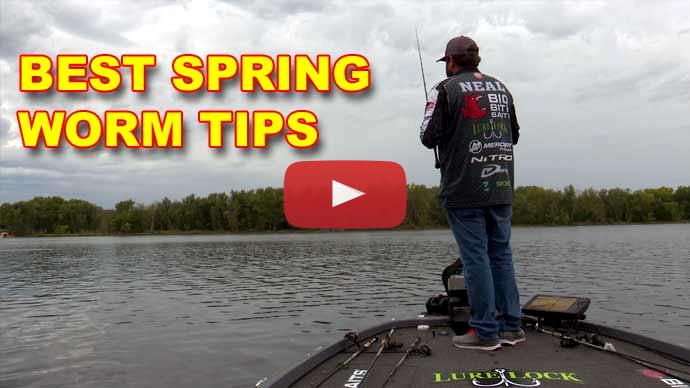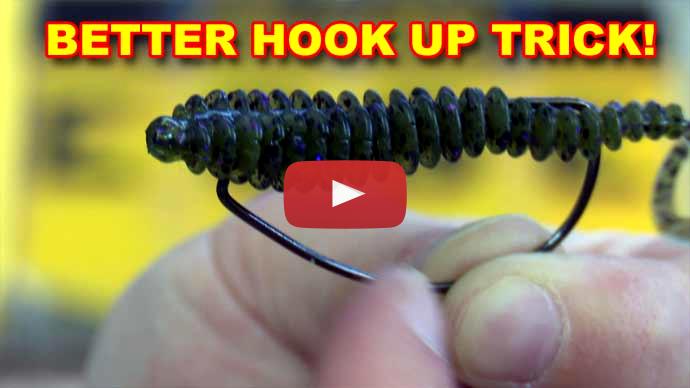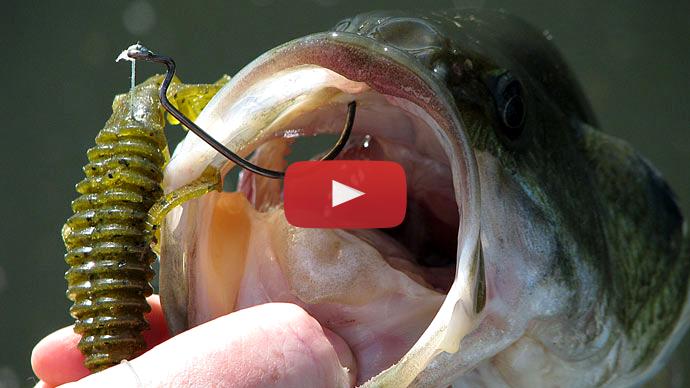So, we're talking about fishing Texas Rig plastic baits from the shoreline. I wanna talk about basically from spring all the way through the fall. This can be a killer way to catch a lot of fish from the shoreline. So, I wanna talk a little bit about my setup and what I'm using, and then talk about how I fish this Texas Rig Baits throughout the fall, spring, and summer.
Here, what I'm doing, I got a 7-foot, maybe 7-foot-2 medium-heavy power rod with a fast action tip. This is kind of a jack-of-all-trades rod. You can throw all kinds of lures on it, seriously. You can throw spinnerbaits and buzzbaits and jigs and whatnot. It's a very versatile rod, which is key when you're fishing in front of the bank because you can't carry a bunch of rods. So, this is kind of your universal rod you would use from the bank. But it's an excellent rod for fishing Texas Rig plastics. As a matter of fact, I have several dedicated rods for Texas Rig plastics and they're all just like this. They're all 7'1" to 7'3", medium-heavy power, fast action rods.
I've got a 15-pound Seaguar InvizX fluorocarbon line, not braid. I'm not using any leader or anything like that. Again, versatility is the key. This 15-pound InvizX line, that is like you can use it anywhere you go. It'll fish through rocks, through weeds, through cover, anything. And that braid is more of a specialty. For example, if you're fishing a lot of woody cover, a lot of flooded bushes, and timber, braid tends to dig into the wood more than fluorocarbon. And if you're fishing around rocks, well, braid tends to get nicked up and frayed more than fluorocarbon. So, I use fluorocarbon. You need that when you're fishing from the bank because you don't know all the stuff you're gonna be fishing and you need that versatility because you can't carry 10 rods with you.
Paired with it is a reel. It's got a 6.3 to 1 gear ratio, a low speed. You know, 6.1 to 6.3 is perfect for fishing Texas Rig. You don't typically need a fast-speed reel, like a 7.0 to 5 or 8.0 to 1 gear ratio. You don't need something that fast because, you know, you're working there relatively slow. So, that's my rig. Oh, and I'm also using a 3-yard Gamakatsu extra wide gap hook. Just a normal wired hook on here. I'm not using a flipping hook. And then I've got a 3/8-ounce tungsten weight. That's standard. These baits, typically, you know how bulky they are. This is a RageTail Rooster. They're bulky, they've got a lot of appendages on them, they take a little bit more weight to get through the water to get everything wiggling and moving the way they're supposed to and fall naturally. A lighter weight. They tend to fall like a dead piece of plastic. So, a three-eighth is pretty standard for me during most of the seasons.
And what I'll do is there are several main ways which I fish it. First of all, when the water's cold, like in the early spring, in the late fall, what I'll do is I'll cast it out there, and when you cast it out there, you want to give it a lot of slack, right? You want it to fall on a slackline. You don't want to do the...you know. I got my...There we go. You don't cast out there and then just cock the reel. Cast out there and give it some extra line and let it fall on a slackline. When it does that, oftentimes that's when the fish bite. So, how do you feel the bite? Well, you can't because you're on a slackline. So, you have to be a line watcher. Pay real close attention to where that line goes in the water and look for any changes. Oftentimes it'll jump or twitch or it'll just speed up as it's sinking into the water. And, well, that's a fish that's doing that, not you, so set the hook.
Once it hits the bottom, then reel down to it, and you want to feel a little bit, see if there's a bite. Sometimes the fish will be there and you'll feel a little tug, set the hook. But if there isn't a fish there, then when the water's real cold what I'll do is I'll just drag it on the bottom. I'll just do that with the rod. I'll just pull it along the bottom, give it about, you know, 6 to 8 inches pull, just very slow pull, and then pause. And the pause will go anywhere from say 5 to 30 seconds and sometimes longer. You have to experiment every day because the fish, they change their moods every day so I can't be prescriptive here. You just have to experiment with the length of that pause to see what it is that's gonna trigger that bite. But after that pause, then you move it again another 5, 8 inches, pause, wait, and so on, and so forth until you get it all the way back to you. That is like bread and butter when the water's in the say, upper 40s to low 50s.
Now when the water temperature is a little bit warmer than that, say in the mid-50s and upper-50s, what I'll do then is when the bait hits the bottom, I'll let it rest for maybe a few seconds, maybe, you know, a little bit of a short pause, and then lift up on the rod and let it drop back down. And I'll reel up some of the slack as I bring the rod back down. But I'm not using the reel to reel in the bait, I'm just using the rod tip. So, you're lifting the bait up off the bottom, let it flutter back down. A lot of times the bite happens when it's falling. And if the water's really warm it just hits the bottom, I lift up. As the water warms up, I speed this up. Lift up and let it pop. No, reel down, lift up, let it pop, let it drop. No bite after, like, two or three drops, I just reel it and cast again. Don't work it all the way back to the shore. A lot of times the fish won't bite it. You can experiment with that because sometimes they will. But, you know, as a general rule, if they don't bite it in the first hop or two, typically you need to recast to something else.
Another way I like to fish Texas Rig Baits is I like to swim them back to me. This works, again, anytime the water temp is in the upper 50s and above. Cast it out there. And I'll still use the 3/8-ounce weight to begin with, but sometimes I'll lighten up, do a 1/4-ounce weight for this technique because I don't want it to sink down into the bushes. Here I just want to slowly reel the bait back and let the appendages just flat and flutter and make it look like something swimming back.
Just a steady crank is really all you need. But you can also play around with that. You can pause during the retrieve. You can yo-yo the rod up and down as you're reeling it. Those types of things can trigger bites. In essence, what you're doing is you're using this Texas Rig Bait like you would a crankbait because let's face it, fishing crankbaits from the shoreline is pretty difficult. You get hung up a lot. Well, Texas Rig Bait, not so much. You can fish it over the weeds, you can fish it over rocks and things and it's not gonna get stuck like you would a crankbait and you're gonna lose an expensive lure. So, fish a Texas rigged bait just like you would a crankbait. And you can catch a lot of fish that way. A lot of fish don't see that presentation by the way. So, that works really well.
Now, another way I like to fish it back is, again, this is almost weightless but 1/8-ounce to a 1/4-ounce weight on it. Throw it out there, and after it gets to the surface, just start reeling it. Don't burn it back, but just you want it to gurgle and slowly swim across the surface back to you. It's just a little topwater bait. This works especially well when the fish are used to seeing buzz baits and topwater and other lures. They haven't seen this. This is a technique that most people don't do with their Texas rig baits. It's just swimming it across the surface very slowly. Looks like a little animal, a little critter just swimming across the surface. And you can get some vicious, vicious strikes doing that because a fish, they really think it's something alive. They're not used to seeing it. So, that works exceptionally well.
What I like to do during the spawn is a little bit different though. In the spawn, I'm gonna put away this rod and reel. Instead, I'm gonna pick up a spinning rod and I'll go to 10-pound fluorocarbon line. It'll be the same thing. It'll be a 7'2" to 7'3", medium-heavy, fast-action spinning rod, but with a 10-pound fluorocarbon line. And I'll go weightless on my Texas rig bait or maybe 1/8-ounce, just real light. All you want it to do is when it falls to the water, move slow enough or just fast enough for the appendages to move. But you don't want it to go shooting through the water column.
The reason is it's gonna land much softer on the water so it has less likelihood of spooking the bass. And also when it lands on the bottom of the floor, right next to the nest or on it, it doesn't hit with this big thud and spook the fish. Real subtle way of fishing these fish that are on these beds, oftentimes, they're real skittish.
So, for that reason, there's two things you need to do. One is you need to make long casts. So, get away from the edge of the shoreline. You don't want to alert the fish to your presence. So, get away from it, walk around the beds, but make long casts. Sometimes you're 30 feet off away from the shoreline, away from the water's edge, but make a long cast past the bed, 3 to 4 feet, 5 feet past the bed, and then slowly work that bait. Let it swim downwards towards the nest and land on the nest. And a lot of times that's how you trigger a strike. So, just be careful about that as fish like to nest right up on or against the shoreline. So, walking on the edge of the shoreline, typically not a good thing during the spawn. You're just gonna alert the fish and you're gonna scare them all off.
For that matter, when you are fishing from the shoreline, a couple of things you want to pay attention to, for example, your shadow. Here, I got the sun coming over me and my shadow's in front of me. You don't want your shadow in front of you because that might alert the fish to your presence. So, instead, I'd fish this direction. So, I'm fishing ahead of my shadow and I'm not spooking the fish.
Also, you want to again be very careful, light-footed step. Don't stomp and you're not carrying your tackle box with you or your backpack and, you know, thump it down on the ground or you're pushing your way through bushes. You know, get away from the shoreline when you make your movements, when you change to another position along the shoreline. Get away from the shoreline, a good 30, 40, 50 feet. Work your way around and then reposition yourself if you can, just so you're not making so much commotion right on the shoreline and you're not alerting those bass to your presence. Those little things can make a big difference when you're fishing from the shoreline.
The last little tip I want to give you is in the fall. I change things up a little bit in the fall. I'll actually go to a 1/2-ounce weight on these baits. By the time the fall rolls around, the fish have seen it all. They've had everything thrown at them and they're used to seeing the fall rate of these plastic baits. So, here I go. A little bit heavier, 1/2-ounce, sometimes up to 3/4-ounce. But I want the bait to just fall through the water real quick. I wanna make them react. I'm forcing that bite. They don't have the chance to really see it. They gotta hit it or let it go.
So, a lot of times, you know, when you're fishing the bait with a 3/8-ounce weight during the fall and the fish are just following it or they're nipping at it, go with a heavier weight, 1/2-ounce or more and see if that triggers bites. Oftentimes it does. It doesn't really work the rest of the year, but that's what I do during the fall. I find that I catch a lot more fish with a heavier weight.
So, hope that helps. For more tips and tricks like this...Wait, hold on, hold on. If you watch the video this long, then you for sure don't wanna miss these two videos, right? Now, this one, I handpicked for you because I think this is the one you're gonna wanna see next, but this is the one that YouTube thinks that you should watch. Either way, I'm in both of them. So, I'll see you in a few seconds.



